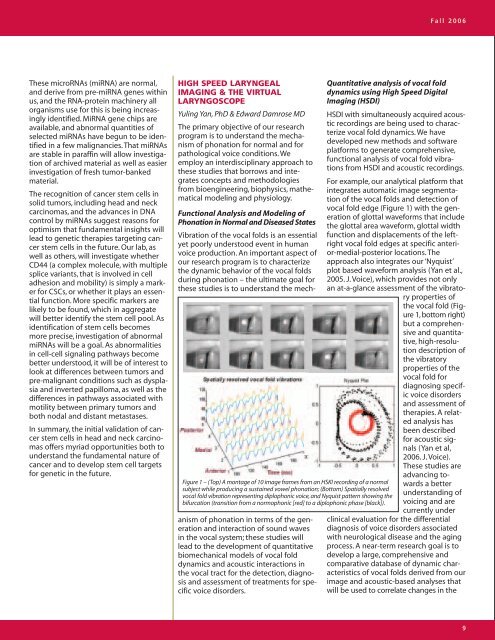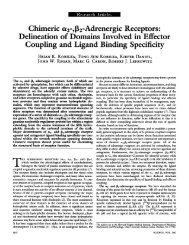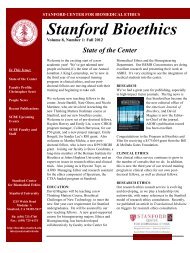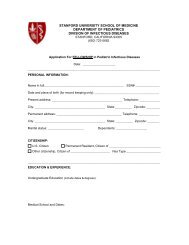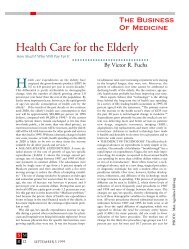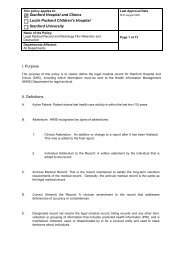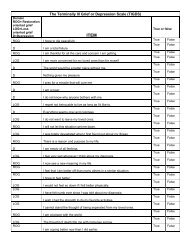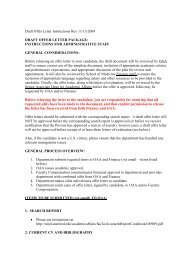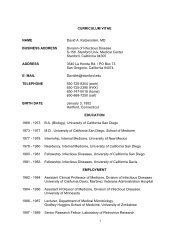HEAD & NECK SURGERY - Stanford University School of Medicine
HEAD & NECK SURGERY - Stanford University School of Medicine
HEAD & NECK SURGERY - Stanford University School of Medicine
You also want an ePaper? Increase the reach of your titles
YUMPU automatically turns print PDFs into web optimized ePapers that Google loves.
These microRNAs (miRNA) are normal,<br />
and derive from pre-miRNA genes within<br />
us, and the RNA-protein machinery all<br />
organisms use for this is being increasingly<br />
identified. MiRNA gene chips are<br />
available, and abnormal quantities <strong>of</strong><br />
selected miRNAs have begun to be identified<br />
in a few malignancies. That miRNAs<br />
are stable in paraffin will allow investigation<br />
<strong>of</strong> archived material as well as easier<br />
investigation <strong>of</strong> fresh tumor-banked<br />
material.<br />
The recognition <strong>of</strong> cancer stem cells in<br />
solid tumors, including head and neck<br />
carcinomas, and the advances in DNA<br />
control by miRNAs suggest reasons for<br />
optimism that fundamental insights will<br />
lead to genetic therapies targeting cancer<br />
stem cells in the future. Our lab, as<br />
well as others, will investigate whether<br />
CD44 (a complex molecule, with multiple<br />
splice variants, that is involved in cell<br />
adhesion and mobility) is simply a marker<br />
for CSCs, or whether it plays an essential<br />
function. More specific markers are<br />
likely to be found, which in aggregate<br />
will better identify the stem cell pool. As<br />
identification <strong>of</strong> stem cells becomes<br />
more precise, investigation <strong>of</strong> abnormal<br />
miRNAs will be a goal. As abnormalities<br />
in cell-cell signaling pathways become<br />
better understood, it will be <strong>of</strong> interest to<br />
look at differences between tumors and<br />
pre-malignant conditions such as dysplasia<br />
and inverted papilloma, as well as the<br />
differences in pathways associated with<br />
motility between primary tumors and<br />
both nodal and distant metastases.<br />
In summary, the initial validation <strong>of</strong> cancer<br />
stem cells in head and neck carcinomas<br />
<strong>of</strong>fers myriad opportunities both to<br />
understand the fundamental nature <strong>of</strong><br />
cancer and to develop stem cell targets<br />
for genetic in the future.<br />
HIGH SPEED LARYNGEAL<br />
IMAGING & THE VIRTUAL<br />
LARYNGOSCOPE<br />
Yuling Yan, PhD & Edward Damrose MD<br />
The primary objective <strong>of</strong> our research<br />
program is to understand the mechanism<br />
<strong>of</strong> phonation for normal and for<br />
pathological voice conditions. We<br />
employ an interdisciplinary approach to<br />
these studies that borrows and integrates<br />
concepts and methodologies<br />
from bioengineering, biophysics, mathematical<br />
modeling and physiology.<br />
Functional Analysis and Modeling <strong>of</strong><br />
Phonation in Normal and Diseased States<br />
Vibration <strong>of</strong> the vocal folds is an essential<br />
yet poorly understood event in human<br />
voice production. An important aspect <strong>of</strong><br />
our research program is to characterize<br />
the dynamic behavior <strong>of</strong> the vocal folds<br />
during phonation – the ultimate goal for<br />
these studies is to understand the mech-<br />
Figure 1 – (Top) A montage <strong>of</strong> 10 image frames from an HSKI recording <strong>of</strong> a normal<br />
subject while producing a sustained vowel phonation; (Bottom) Spatially resolved<br />
vocal fold vibration representing diplophonic voice, and Nyquist pattern showing the<br />
bifurcation (transition from a normophonic [red] to a diplophonic phase [black]).<br />
anism <strong>of</strong> phonation in terms <strong>of</strong> the generation<br />
and interaction <strong>of</strong> sound waves<br />
in the vocal system; these studies will<br />
lead to the development <strong>of</strong> quantitative<br />
biomechanical models <strong>of</strong> vocal fold<br />
dynamics and acoustic interactions in<br />
the vocal tract for the detection, diagnosis<br />
and assessment <strong>of</strong> treatments for specific<br />
voice disorders.<br />
Fall 2006<br />
Quantitative analysis <strong>of</strong> vocal fold<br />
dynamics using High Speed Digital<br />
Imaging (HSDI)<br />
HSDI with simultaneously acquired acoustic<br />
recordings are being used to characterize<br />
vocal fold dynamics. We have<br />
developed new methods and s<strong>of</strong>tware<br />
platforms to generate comprehensive,<br />
functional analysis <strong>of</strong> vocal fold vibrations<br />
from HSDI and acoustic recordings.<br />
For example, our analytical platform that<br />
integrates automatic image segmentation<br />
<strong>of</strong> the vocal folds and detection <strong>of</strong><br />
vocal fold edge (Figure 1) with the generation<br />
<strong>of</strong> glottal waveforms that include<br />
the glottal area waveform, glottal width<br />
function and displacements <strong>of</strong> the leftright<br />
vocal fold edges at specific anterior-medial-posterior<br />
locations. The<br />
approach also integrates our ‘Nyquist’<br />
plot based waveform analysis (Yan et al.,<br />
2005. J. Voice), which provides not only<br />
an at-a-glance assessment <strong>of</strong> the vibratory<br />
properties <strong>of</strong><br />
the vocal fold (Figure<br />
1, bottom right)<br />
but a comprehensive<br />
and quantitative,high-resolution<br />
description <strong>of</strong><br />
the vibratory<br />
properties <strong>of</strong> the<br />
vocal fold for<br />
diagnosing specific<br />
voice disorders<br />
and assessment <strong>of</strong><br />
therapies. A related<br />
analysis has<br />
been described<br />
for acoustic signals<br />
(Yan et al,<br />
2006. J. Voice).<br />
These studies are<br />
advancing towards<br />
a better<br />
understanding <strong>of</strong><br />
voicing and are<br />
currently under<br />
clinical evaluation for the differential<br />
diagnosis <strong>of</strong> voice disorders associated<br />
with neurological disease and the aging<br />
process. A near-term research goal is to<br />
develop a large, comprehensive and<br />
comparative database <strong>of</strong> dynamic characteristics<br />
<strong>of</strong> vocal folds derived from our<br />
image and acoustic-based analyses that<br />
will be used to correlate changes in the<br />
9


